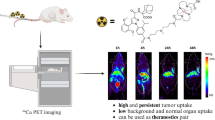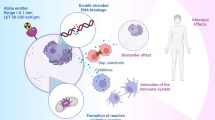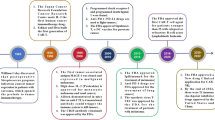Abstract
Interstitial chemotherapeutic drug infusion can bypass the blood–brain barrier, and provide high regional drug concentrations without systemic exposure. However, toxicity and efficacy for drugs administered via interstitial continuous (i.c.) infusion have not been characterized. In the current study, vincristine (VIN) was infused into the right frontal lobes of healthy Fisher 344 rats at 30, 45, 60, and 120 μg/ml over a period of 7 days at 1 μl/h, using an Alzet osmotic pump to evaluate toxicity. C6 rat glioblastoma cells transduced with a luciferase gene were inoculated into the right frontal lobe of a second group of rats. VIN was administered to tumor bearing rats via i.c. infusion 7 days later and tumor growth was monitored by bioluminescence intensity (BLI) to assess VIN efficacy, intravenous (i.v.) drug administration was used as a comparison drug delivery method. The results suggested that VIN toxicity is dose-dependent. Efficacy studies showed increased BLI, which correlates with histopathological tumor size, in saline-infused and i.v.-treated tumor-bearing rats. These rats survived an average of 28 ± 0.85 days and 33 ± 1.38 days, respectively. Both groups had large tumors at the time of death. Animals treated with VIN via i.c. infusion survived until day 90, the observation endpoint for this study. This was significantly longer than average survival times in the previous two groups. These results demonstrate that VIN via i.c. infusion is effective in reducing C6 glioblastoma tumors and prolonging rodent survival time compared to i.v. injection and suggest that chemotherapeutic drug administration via i.c. infusion may be a promising strategy for treating malignant brain tumors.




Similar content being viewed by others
References
Bidros DS, Vogelbaum MA (2009) Novel drug delivery strategies in neuro-oncology. Neurotherapeutics 6:539–546
Stukel JM, Caplan MR (2009) Targeted drug delivery for treatment and imaging of glioblastoma multiforme. Expert Opin Drug Deliv 6:705–718
Ghose A, Lim G, Husain S (2010) Treatment for glioblastoma multiforme: current guidelines and Canadian practice. Curr Oncol 17:52–58
Olivi A, Grossman SA, Tatter S et al (2003) Dose escalation of carmustine in surgically implanted polymers in patients with recurrent malignant glioma: a new approaches to brain tumor therapy cns consortium trial. J Clin Oncol 21:1845–1849
Raizer JJ, Malkin MG, Kleber M, Abrey LE (2004) Phase 1 study of 28-day, low-dose temozolomide and BCNU in the treatment of malignant gliomas after radiation therapy. Neuro Oncol 6:247–252
Buonerba C, Di Lorenzo G, Marinelli A et al (2010) A comprehensive outlook on intracerebral therapy of malignant gliomas. Crit Rev Oncol Hematol. doi:10.1016/j.critrevonc.2010.09.001
Tepe P, Hassenbusch SJ, Benoit R, Anderson JH (1991) BCNU stability as a function of ethanol concentration and temperature. J Neurooncol 10:121–127
Goodisman J, Souid AK (2006) Constancy in integrated cisplatin plasma concentrations among pediatric patients. J Clin Pharmacol 46:443–448
Preiss R, Baumann F, Regenthal R, Matthias M (2006) Plasma kinetics of procarbazine and zao-procarbazine in humans. Anticancer Drugs 17:75–80
Bedikian AY, Vardeleon A, Smith T, Campbell S, Namdari R (2006) Pharmacokinetics and urinary excretion of vincristine sulfate liposomes injection in metastatic melanoma patients. J Clin Pharmacol 46:727–737
Lauer AK, Wobig JL, Shults WT, Neuwelt EA, Wilson MW (1999) Severe ocular and orbital toxicity after intracarotid etoposide phosphate and carboplatin therapy. Am J Ophthalmol 127:230–233
Qureshi AI, Suri MF, Khan J, Sharma M et al (2001) Superselective intra-arterial carboplatin for treatment of intracranial neoplasms: experience in 100 procedures. J Neurooncol 51:151–158
Imbesi F, Marchioni E, Benericetti E et al (2006) A randomized phase III study: comparison between intravenous and intraarterial ACNU administration in newly diagnosed primary glioblastomas. Anticancer Res 26:553–558
Lawson HC, Sampath P, Bohan E et al (2007) Interstitial chemotherapy for malignant gliomas: the Johns Hopkins experience. J Neurooncol 83:61–70
Sampath P, Rhines LD, DiMeco F, Tyler BM, Park MC, Brem H (2006) Interstitial docetaxel (taxotere), carmustine and combined interstitial therapy: a novel treatment for experimental malignant glioma. J Neurooncol 80:9–17
Brem S, Tyler B, Li K et al (2007) Local delivery of temozolomide by biodegradable polymers is superior to oral administration in a rodent glioma model. Cancer Chemother Pharmacol 60:643–650
Sugiyama S, Yamashita Y, Kikuchi T, Saito R, Kumabe T, Tominaga T (2007) Safty and efficacy of convection-enhanced delivery of ACNU, a hydrophilic nitrosourea, in intracranial brain tumor models. J Neurooncol 82:41–47
Tange Y, Kondo A, Egorin MJ et al (2009) Interstitial continuous infusion therapy in a malignant glioma model in rats. Childs Nerv Syst 25:655–662
Kondo A, Goldman S, Lulla RR et al (2009) Longitudinal assessment of regional directed delivery in a rodent malignant glioma model. J Neurosurg Pediatrics 4:592–598
Kondo A, Goldman S, Vanin EF et al (2009) An experimental brainstem tumor model using in vivo bioluminescence imaging in rat. Childs Nerv Syst 25:527–533
Luther N, Cheung NK, Souliopoulos EP et al (2010) Interstitial infusion of glioma-targeted recombinant immunotoxin 8H9sc Fv-PE38. Mol Cancer Ther 9:1039–1046
Carpentier A, McNichols RJ, Stafford RJ et al (2008) Real-time magnetic resonance-guided laser thermal therapy for local metastatic brain tumors. Neurosurgery 63:21–29
Rueger MA, Winkeler A, Thomas AV, Kracht LW, Jacobs AH (2008) Molecular imaging-guided gene therapy of gliomas. Handb Exp Pharmacol 185:341–359
Szentirmai O, Baker CH, Lin N et al (2006) Noninvasive bioluminescence imaging of luciferase expressing intracranial U87 xenografts: correlation with magnetic resonance imaging determined tumor volume and longitudinal use in assessing tumor growth and antiangiogenic treatment effect. Neurosurgery 58:365–372
Hollingshead MG, Nonomi CA, Borgel SD et al (2004) A potential role for imaging technology in anticancer efficacy evaluations. Eur J Cancer 40:890–898
Lee CJ, Spalding AC, Ben-Josef E, Wang L, Simeone DM (2010) In vivo bioluminescent imaging of irradiated orthotopic pancreatic cancer xenografts in nonobese diabetic-severe combined immunodeficient mice: a novel method for targeting and assaying efficacy of ionizing radiation. Transl Oncol 3:153–159
Barth RF, Kaur B (2009) Rat brain tumor models in experimental neuro-oncology: the C6, 9L, T9, RG2, F98, BT4C, RT-2 and CNS-1 gliomas. J Neurooncol 94:299–312
Tagscherer KE, Fassl A, Campos B, Farhadi M, Kraemer A, Bock BC et al (2008) Apoptosis-based treatment of glioblastoma with ABT-737, a novel small molecule inhibitor of Bcl-2 family proteins. Oncogene 27:6646–6656
Ashley DM, Riffkin CD, Lovric MM, Mikeska T, Dobrovic A, Maxwell JA et al (2008) In vitro sensitivity testing of minimally passaged and uncultured gliomas with TRAIL and/or chemotherapy drugs. Br J Cancer 99:294–304
Watts RG, Merchant RE (1992) Cerebrovascular effects and tumor kinetics after a single intratumoral injection of human recombinant interkeukin-2 alone or in combination with intravenous chemotherapy in a rat model of glioma. Neurosurgery 31:89–98
Tao-Cheng JH, Gallant EP, Brightman WM, Dosemeci A, Reese TS (2007) Structural changes at synapses after delayed perfusion fixation in different regions of the mouse brain. J Comp Neurol 501:731–740
Hynynen K, Pomeroy O, Smith DN et al (2001) MR imaging-guided focused ultrasound surgery of fibroadenomas in the breast: a feasibility study. Radiology 219:176–185
Jenkins DE, Oei Y, Hornig YS et al (2003) Bioluminescent imaging (BLI) to improve and refine traditional murine models of tumor growth and metastasis. Clin Exp Metastasis 20:733–744
Butowski NA, Sneed PK, Chang SM (2006) Diagnosis and treatment of recurrent high-grade astrocytoma. J Clin Oncol 24:1273–1280
Qweider M, Gilsbach JM, Rohde V (2007) Inadvertent intrathecal vincristine administration: a neurosurgical emergency. Case report. J Neurosurg Spine 6:280–283
Oliver AS, Firth G, McKeran RO (1985) Studies on the intracerebral injection of vincristine free and entrapped within liposomes in the rats. J Neurol Sci 65:25–30
Origitano TC, Reichman OH (1993) Photodynamic therapy for intracranial neoplasms: development of an image-based computer-assisted protocol for photodynamic therapy of intracranial neoplasms. Neurosurgery 32:587–595; discussion 595–596
Chen ZJ, Broaddus WC, Viswanathan RR, Raghavan R, Gillies GT (2002) Intraparenchymal drug delivery via positive-pressure infusion: experimental and modeling studies of poroelasticity in brain phantom gels. IEEE Trans Biomed Eng 49:85–96
Lawson HC, Sampath P, Bohan E et al (2007) Interstitial chemotherapy for malignant gliomas: the Johns Hopkins experience. J Neurooncol 83:61–70
Saito R, Kumabe T, Jokura H, Yoshimoto T (2002) Fatal hemorrhage after radiochemotherapy for leptomeningeal dissemination of glioma: report of two cases. Surg Neurol 57:46–48
Kanda M, Tanaka H, Shinoda S, Masuzawa T (2002) Leptomeningeal dissemination of pilocytic astrocytoma via hematoma in a child. case report. Neurosurg Focus 13: ECP2
Acknowledgments
We acknowledge practice manager of neurosurgical department Sana Abbed for her kindly organization for this project and Dr. Jose Hernandez for his help in the animal housing. We also acknowledge the Department of Pathology and Laboratory Medicine, Children’s Memorial Hospital, Chicago, IL, USA, and all the members of the Soares Laboratory (Cancer Biology and Epigenomics Program, Children’s Memorial Research Center) for their technical advice. This project was supported by the Rory David Deutsch Foundation, the Neuro-Oncology Research Foundation of Children’s Memorial Hospital and the Dr. Ralph and Marian C. Falk Medical Research Trust (all Chicago, IL, USA)
Author information
Authors and Affiliations
Corresponding author
Additional information
Guifa Xi was previously affiliated with Department of Neurosurgery, Tongji Hospital, Tongji Medical College, Huazhong University of Science and Technology, Wuhan, People’s Republic of China.
Electronic supplementary material
Below is the link to the electronic supplementary material.
11060_2011_680_MOESM1_ESM.tif
In vitro bioluminescene of rat C6-Luc glioblastoma cell lines expressing luciferase. A C6-Luc cells were diluted from 312 to 10,000 cells/well, in triplicate and imaged for 30 s after addition of luciferin to the culture media. Negative controls were not treated with luciferin (TIFF 148 kb)
11060_2011_680_MOESM2_ESM.tif
In vitro bioluminescene of rat C6-Luc glioblastoma cell lines expressing luciferase. B Correlation between cell number and mean bioluminescence (photons/s/cm2/steradian) (r2 = 0.9979) (TIFF 39 kb)
Rights and permissions
About this article
Cite this article
Xi, G., Mania-Farnell, B., Rajaram, V. et al. Efficacy of interstitial continuous vincristine infusion in a bioluminescent rodent intracranial tumor model. J Neurooncol 106, 261–270 (2012). https://doi.org/10.1007/s11060-011-0680-8
Received:
Accepted:
Published:
Issue Date:
DOI: https://doi.org/10.1007/s11060-011-0680-8




